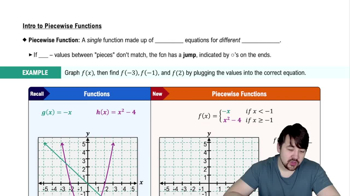Find all points on the curve y = tan x, −π/2 < x < π/2, where the tangent line is parallel to the line y = 2x. Sketch the curve and tangent lines together, labeling each with its equation.
Table of contents
- 0. Functions7h 54m
- Introduction to Functions16m
- Piecewise Functions10m
- Properties of Functions9m
- Common Functions1h 8m
- Transformations5m
- Combining Functions27m
- Exponent rules32m
- Exponential Functions28m
- Logarithmic Functions24m
- Properties of Logarithms36m
- Exponential & Logarithmic Equations35m
- Introduction to Trigonometric Functions38m
- Graphs of Trigonometric Functions44m
- Trigonometric Identities47m
- Inverse Trigonometric Functions48m
- 1. Limits and Continuity2h 2m
- 2. Intro to Derivatives1h 33m
- 3. Techniques of Differentiation3h 18m
- 4. Applications of Derivatives2h 38m
- 5. Graphical Applications of Derivatives6h 2m
- 6. Derivatives of Inverse, Exponential, & Logarithmic Functions2h 37m
- 7. Antiderivatives & Indefinite Integrals1h 26m
- 8. Definite Integrals4h 44m
- 9. Graphical Applications of Integrals2h 27m
- 10. Physics Applications of Integrals 3h 16m
- 11. Integrals of Inverse, Exponential, & Logarithmic Functions2h 31m
- 12. Techniques of Integration7h 41m
- 13. Intro to Differential Equations2h 55m
- 14. Sequences & Series5h 36m
- 15. Power Series2h 19m
- 16. Parametric Equations & Polar Coordinates7h 58m
3. Techniques of Differentiation
Derivatives of Trig Functions
Problem 3.5.52
Textbook Question
Is there a value of b that will make
g(x) = { x + b, x < 0
cos x, x ≥ 0
continuous at x = 0? Differentiable at x = 0? Give reasons for your answers.
 Verified step by step guidance
Verified step by step guidance1
To determine if the function g(x) is continuous at x = 0, we need to check if the left-hand limit as x approaches 0 from the negative side equals the right-hand limit as x approaches 0 from the positive side, and both equal g(0).
Calculate the left-hand limit: As x approaches 0 from the left (x < 0), g(x) = x + b. The limit is lim(x→0⁻)(x + b) = 0 + b = b.
Calculate the right-hand limit: As x approaches 0 from the right (x ≥ 0), g(x) = cos(x). The limit is lim(x→0⁺)cos(x) = cos(0) = 1.
For g(x) to be continuous at x = 0, the left-hand limit must equal the right-hand limit and g(0). Therefore, set b = 1 to make the function continuous at x = 0.
To determine differentiability at x = 0, check if the derivative from the left equals the derivative from the right. The derivative of x + b is 1, and the derivative of cos(x) at x = 0 is 0. Since these derivatives are not equal, g(x) is not differentiable at x = 0.
 Verified video answer for a similar problem:
Verified video answer for a similar problem:This video solution was recommended by our tutors as helpful for the problem above
Video duration:
6mPlay a video:
Was this helpful?
Key Concepts
Here are the essential concepts you must grasp in order to answer the question correctly.
Continuity
A function is continuous at a point if the limit of the function as it approaches the point from both sides equals the function's value at that point. For g(x) to be continuous at x = 0, the left-hand limit (as x approaches 0 from the left) and the right-hand limit (as x approaches 0 from the right) must both equal g(0).
Recommended video:

Intro to Continuity
Differentiability
A function is differentiable at a point if it has a defined derivative at that point, meaning the function's rate of change is consistent from both sides. For g(x) to be differentiable at x = 0, it must first be continuous at x = 0, and the left-hand derivative and right-hand derivative at x = 0 must be equal.
Recommended video:

Finding Differentials
Piecewise Functions
Piecewise functions are defined by different expressions over different intervals. Understanding how to evaluate limits and derivatives for each piece is crucial. For g(x), we must analyze the behavior of x + b for x < 0 and cos x for x ≥ 0 separately, then ensure they align at x = 0 for continuity and differentiability.
Recommended video:

Piecewise Functions

 3:53m
3:53mWatch next
Master Derivatives of Sine & Cosine with a bite sized video explanation from Patrick
Start learningRelated Videos
Related Practice
Textbook Question
